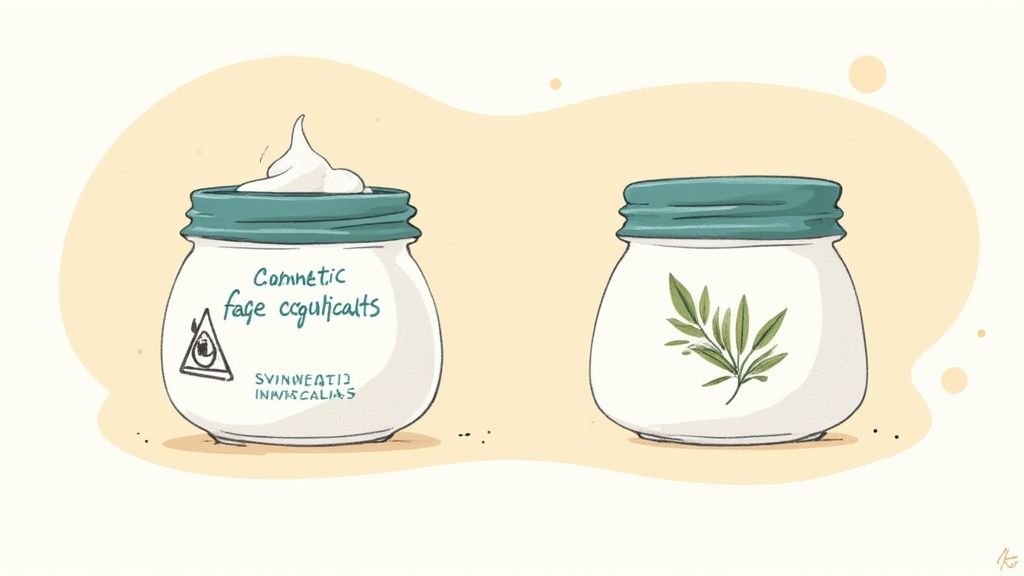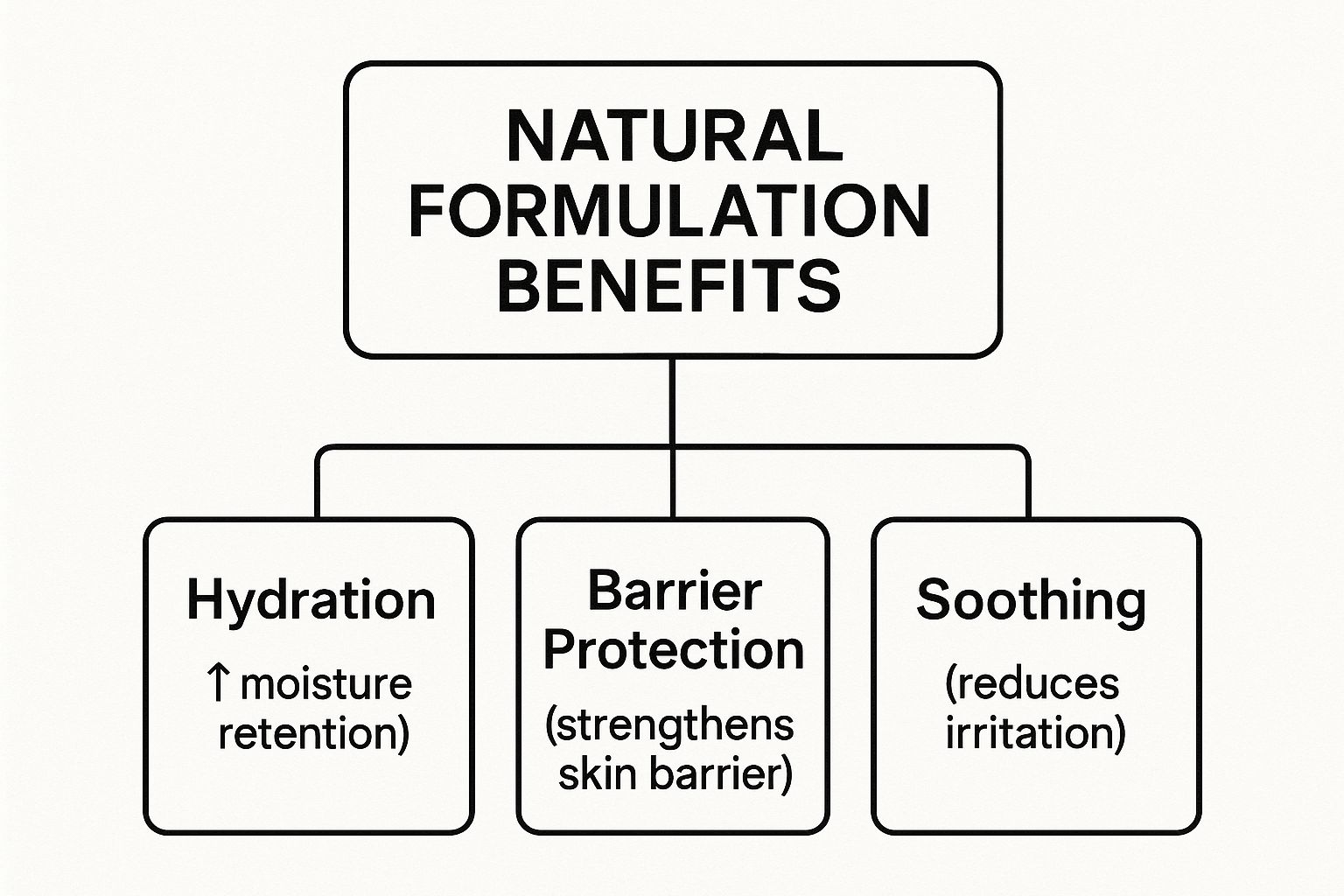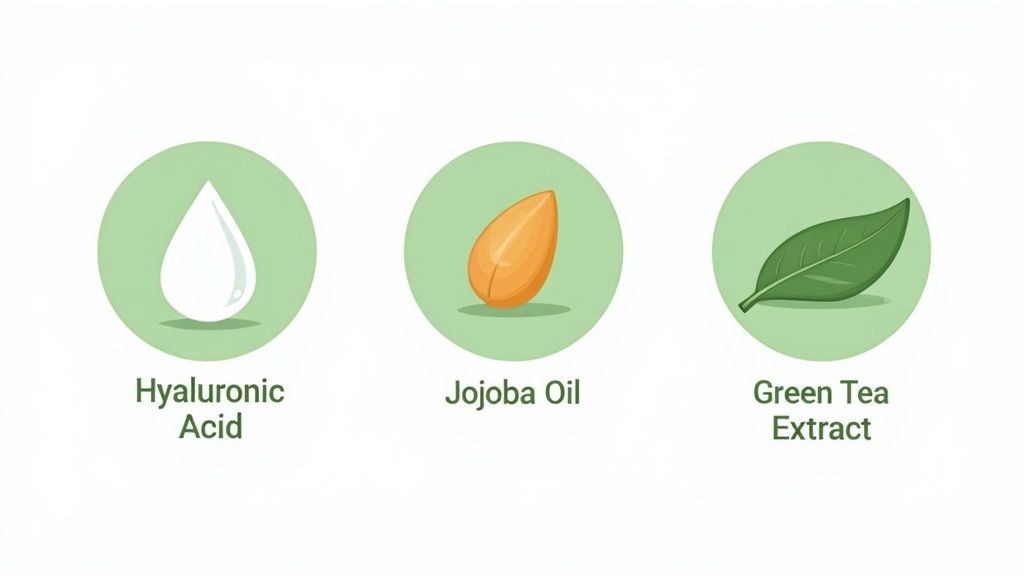When you hear the term "chemical-free face cream," what probably comes to mind is a product made without the harsh, synthetic ingredients often found in mass-market skincare—things like parabens, sulfates, and artificial fragrances. That's exactly the right idea.
These creams skip the synthetic stuff and instead lean on natural, plant-derived ingredients to nourish and hydrate your skin. The whole point is to deliver effective moisture with ingredients your skin instinctively knows how to use.
What Does Chemical-Free Skincare Really Mean?

Let's get one thing straight right away. From a purely scientific standpoint, the term "chemical-free" is a little misleading. After all, everything is made of chemicals, including water (H₂O) and the natural oils produced by your own skin.
But in the world of skincare, "chemical-free" isn't about defying chemistry. It's really just shorthand for a skincare philosophy that avoids potentially harsh, irritating, or questionable synthetic chemicals.
Think of it like this: an apple and a brightly-colored, artificially-flavored candy are both technically made of chemical compounds. But one is a whole food that nourishes your body, while the other is loaded with artificial colors, flavors, and preservatives that your body simply doesn't need. A chemical-free face cream applies that same logic to what you put on your skin, choosing simple, natural alternatives over complex synthetic ones.
The Core Principles of Clean Formulations
The move toward cleaner skincare is all about ingredient transparency and safety. The goal is simple: to support your skin's natural barrier, not strip it down with aggressive compounds. This approach is built on a few key ideas:
- Ingredient Simplicity: Fewer, more recognizable ingredients mean a lower risk of irritation, which is a game-changer for anyone with sensitive skin.
- Avoiding Known Irritants: These formulas deliberately leave out the usual suspects known for causing trouble, including parabens, phthalates, sulfates, and synthetic fragrances.
- Supporting Skin Health: The focus is on ingredients that feed your skin what it needs, like essential fatty acids, vitamins, and antioxidants that help strengthen and protect it.
This isn't just a niche trend anymore; it's a massive shift in how people think about skincare. The global market for organic skincare is expected to balloon from $12.57 billion in 2024 to $27.14 billion by 2033. This incredible growth is fueled by people like you who are paying closer attention to ingredient labels and demanding safer, cleaner options.
At its heart, choosing a chemical-free face cream is about making an intentional choice. It’s about prioritizing long-term skin wellness over short-term fixes and understanding that what you leave out of a product is just as important as what you put in.
This philosophy is especially vital for anyone dealing with dry, sensitive, or reactive skin. By cutting out all the unnecessary additives, these products can deliver pure, effective hydration without the risk of causing a flare-up. You can find more products that follow this approach in our complete guide to chemical-free skincare products.
Why Your Skin Thrives on Natural Formulations
Choosing a natural face cream isn’t just about dodging a few bad ingredients; it's about actively feeding your skin with formulas that genuinely support its natural functions. Imagine your skin's protective barrier as a delicate ecosystem. Many conventional creams can act like harsh detergents, stripping away the very oils your skin needs to stay healthy and disrupting this fragile balance.
This disruption is often what leads to the problems we’re trying to fix in the first place—that cycle of dryness, tightness, redness, and sensitivity. You end up relying on a product that might actually be causing the irritation. A chemical free face cream, on the other hand, is built from the ground up to respect and reinforce your skin’s natural defenses.
Strengthening Your Skin From the Inside Out
Natural formulas are full of ingredients your skin instinctively recognizes and knows how to use. Things like plant butters, botanical extracts, and nourishing oils deliver the essential fatty acids, vitamins, and antioxidants needed to repair and fortify the skin barrier.
Instead of just masking the problem by sitting on the surface, these ingredients actually integrate with your skin’s cellular structure. This helps your skin hold onto moisture better and defend itself against daily environmental stressors. You’re not just getting temporary relief; you’re building the foundation for healthier, more resilient skin for the long haul.
The infographic below breaks down the three core ways natural formulations support your skin.

As you can see, it's all connected. Better hydration leads to a stronger barrier, which naturally reduces irritation and leaves you with a calmer, happier complexion.
Calming Sensitive and Reactive Skin
If you live with eczema, rosacea, or just constant redness, you know how one wrong product can trigger a major flare-up. So many of these reactions are caused by specific synthetic compounds that are unfortunately common in skincare.
Synthetic fragrances are one of the biggest culprits behind skin irritation and allergic reactions. That simple word "fragrance" on a label can hide a cocktail of dozens of undisclosed chemicals, many of which are known irritants.
Simply getting rid of these triggers is often the most powerful first step toward getting calm, comfortable skin. When you switch to a product free from synthetic fragrances, parabens, and sulfates, you’re removing the usual suspects that cause inflammation. This gives your skin the breathing room it needs to finally heal and find its balance.
Someone with rosacea, for instance, might see a dramatic reduction in flushing just by swapping their cream for one made with simple, food-grade ingredients. This is where ingredients that are biologically similar to our own skin's oils truly shine. You can dive deeper into the incredible compatibility and benefits of using beef tallow for skin in our detailed guide.
The Power of Nutrient-Dense Ingredients
One of the biggest wins with natural face creams is the sheer quality of the ingredients. These formulas are packed with minimally processed, nutrient-rich components that work overtime for your skin.
- Vitamins: Ingredients like tallow and sea buckthorn oil are brimming with fat-soluble vitamins A, D, E, and K, which are crucial for skin cell regeneration and protection.
- Antioxidants: Botanical extracts from sources like green tea or chamomile help fight off free radicals, protecting your skin from environmental damage and premature aging.
- Essential Fatty Acids: Oils like jojoba and squalane have a fatty acid profile that closely mimics our skin’s natural sebum, helping to lock in moisture without clogging pores.
This approach delivers a potent, direct dose of nourishment to your skin. By feeding it with high-quality, recognizable ingredients, a chemical free face cream helps your skin function exactly as it should, revealing a glow that is naturally healthy and radiant.
The Powerhouse Ingredients Inside Natural Face Creams

Diving into the world of natural skincare can feel a bit like learning a new language. But once you get familiar with the key players, an ingredient list goes from a confusing wall of text to a clear roadmap for your skin's health. The very best chemical free face cream formulas are built around specific, high-impact ingredients that hydrate, nourish, and protect.
When you know what to look for, you can see right past the flashy marketing claims and choose a product based on what actually works. Let's break down the heroes of the natural skincare world so you can become a pro at spotting what your skin needs.
Deep Hydrators to Quench Thirsty Skin
Hydration is everything. Seriously, it’s the foundation of healthy, glowing skin. Think of your skin cells as tiny sponges; when they're full of water, your complexion looks plump, smooth, and radiant. Dehydrated cells, on the other hand, look shrunken and dull, making fine lines stand out. Natural hydrators are brilliant at drawing moisture into the skin and—crucially—locking it there.
Two of the most effective and gentle hydrators you'll find are:
- Hyaluronic Acid: Don't let the word "acid" throw you off; this stuff is incredibly gentle. It’s a humectant that can hold up to 1,000 times its weight in water, making it a superstar for plumping and hydrating every skin type, from oily to bone-dry.
- Glycerin: A classic for good reason, this plant-derived ingredient acts like a moisture magnet. It pulls water from the air right into your skin's outer layer and helps strengthen your skin's barrier to stop that precious moisture from escaping.
Nourishing Oils to Fortify and Balance
Healthy skin needs oil. The right oils can calm irritation, balance sebum, and deliver essential fatty acids to strengthen your skin’s protective barrier. This is especially important for dry and sensitive skin, which often struggles with a compromised barrier. A great chemical free face cream will use oils that work with your skin, not against it.
The goal of using natural oils isn't to make skin greasy. It's to supplement the natural lipids your skin is missing. The best oils mimic your skin's own sebum, so they absorb quickly and deliver nutrients without clogging pores.
Keep an eye out for these skin-compatible oils:
- Jojoba Oil: This is a fascinating one. Structurally, jojoba oil is incredibly similar to our own sebum. This allows it to absorb beautifully and helps balance both dry and oily skin by tricking the skin into thinking it has produced enough oil.
- Squalane: Usually derived from olives, squalane is a lightweight, non-comedogenic oil that delivers exceptional moisture. It sinks in almost instantly, leaving skin feeling soft and supple with zero greasy residue.
These oils are fantastic for bringing comfort and resilience back to skin that feels tight, flaky, or just plain angry.
Protective Antioxidants to Defend Your Skin
Every single day, your skin is under attack from things like UV rays and pollution. These environmental stressors create unstable molecules called free radicals that damage skin cells and speed up the signs of aging. Antioxidants are your skin's personal bodyguards, neutralizing those free radicals before they can cause trouble.
Here are a few top-tier natural defenders you want on your team:
- Green Tea Extract: Packed with powerful compounds called polyphenols, green tea is a potent anti-inflammatory and antioxidant. It's great for soothing redness and protecting skin from environmental aggressors.
- Vitamin C: A true skincare celebrity, Vitamin C is famous for brightening the complexion, supporting collagen production, and providing serious antioxidant protection. It helps fade dark spots and gives skin a more even, luminous tone.
- Vitamin E (Tocopherol): Often paired with Vitamin C for a synergistic boost, Vitamin E is a fat-soluble antioxidant that excels at moisturizing and healing. It helps strengthen the skin barrier and protects cell membranes from damage.
When you see ingredients like these, you know a chemical free face cream is doing more than just moisturizing. It’s a protective shield that actively defends your skin, helping it stay healthy and vibrant for years to come.
To make it even easier, here’s a quick-glance table of some of the best natural ingredients you can find.
Top Natural Ingredients for Healthy Skin
This table breaks down some of the most effective natural ingredients, what they do, and which skin types love them the most.
| Ingredient | Primary Benefit | Best For Skin Type |
|---|---|---|
| Hyaluronic Acid | Deeply hydrates and plumps skin | All, especially dehydrated |
| Squalane | Lightweight moisture, non-greasy | All, including oily & acne-prone |
| Jojoba Oil | Balances oil production, mimics sebum | Combination, oily, and dry |
| Green Tea Extract | Soothes redness, powerful antioxidant | Sensitive, acne-prone, mature |
| Vitamin C | Brightens, boosts collagen, protects | Dull, mature, uneven tone |
| Rosehip Oil | Fades scars, rich in fatty acids | Dry, mature, scarred |
| Shea Butter | Richly moisturizes and nourishes | Very dry, eczema-prone |
| Chamomile | Calms inflammation and irritation | Sensitive, irritated, rosacea-prone |
Using this as a guide, you can start to decipher ingredient lists with confidence, picking out the formulas that are truly packed with the good stuff your skin will thank you for.
Common Chemicals to Avoid in Your Skincare
Trying to decipher a long ingredient list can feel like you need a chemistry degree. But learning what to avoid is just as powerful as knowing which good-for-you ingredients to seek out. Let's create your personal watchlist for common synthetics that frequently show up in skincare, especially the ones that just don't play nice with dry or sensitive skin.
Making smart choices for your skin isn't about creating fear; it's about taking back control. Once you can spot these additives, you gain the confidence to pick a chemical free face cream that truly supports your skin's health. You stop being just a consumer and become your own best advocate.
This push for cleaner ingredients isn't just a niche trend—it's a massive shift. The clean beauty market, built on transparency and ditching questionable synthetics, was valued at a staggering USD 7.29 billion in 2024. Projections show it continuing to grow at a breakneck pace, which tells us one thing: people everywhere are waking up to the potential downsides of certain synthetic ingredients. You can dive deeper into the numbers behind this consumer movement in the full market analysis.
The Big Four Ingredients to Watch For
While the list of synthetic cosmetic ingredients is endless, a few repeat offenders consistently top the "avoid" lists, and for very good reasons. They're often tied to irritation, increased dryness, and even allergic reactions. Here’s a quick look at who they are and why they're in so many products.
- Parabens (e.g., methylparaben, propylparaben): These are simply preservatives. Their job is to stop bacteria and mold from growing in your products, which gives them a longer shelf life.
- Sulfates (SLS & SLES): Sodium lauryl sulfate and its cousin, sodium laureth sulfate, are the chemicals that make cleansers super foamy. They're incredibly good at stripping away oil—sometimes, a little too good.
- Phthalates: You'll rarely see this word on a label. Instead, they're often hiding under the catch-all term "fragrance" and are used to make scents stick around longer.
- Synthetic Fragrances: Speaking of "fragrance," this one simple word can hide a cocktail of dozens of undisclosed chemicals. Many of them are well-known irritants and allergens.
Getting familiar with these names is the first step toward making cleaner, more skin-friendly choices. For a more exhaustive list, be sure to check out our comprehensive guide on skin care ingredients to avoid.
Why These Ingredients Can Be Problematic
So, what's the big deal? The main issue with many of these common chemicals is their ability to weaken your skin's natural protective barrier. Think of this barrier as a tiny, invisible shield responsible for keeping moisture locked in and irritants locked out. When it gets damaged, your skin is left wide open to all sorts of trouble.
Sulfates, for example, are so effective at dissolving oil that they can strip away the natural lipids that hold your skin barrier together. This is what causes that tight, squeaky-clean (but actually very dry) feeling, often kicking off a vicious cycle of inflammation. For anyone with conditions like eczema or rosacea, this can be a real nightmare.
A healthy skin barrier is the foundation of a calm, comfortable complexion. Ingredients that weaken this barrier may provide a short-term cleansing effect but can lead to long-term sensitivity and dehydration.
Synthetic fragrances are another major culprit. Because companies aren't legally required to list the individual chemicals in their fragrance formulas, you're left in the dark about what you’re actually applying. This lack of transparency is a huge red flag, especially for sensitive or reactive skin types, as hidden allergens are one of the most common triggers for redness, itching, and rashes.
By opting for a chemical free face cream made without these additives, you give your skin a real chance to calm down and rebalance. When you take away the potential irritants, you allow your skin's natural healing abilities to kick in, leading to a stronger, more resilient barrier and a complexion that looks and feels genuinely healthy.
How to Choose the Right Natural Face Cream

Walking down the skincare aisle can feel like trying to solve a puzzle with too many pieces. When you’re faced with a wall of options, how do you find the right chemical free face cream? It’s actually simpler than it looks. Forget the marketing hype and focus on a few key things: your skin, the ingredients, and the brand’s credibility.
Once you learn what to look for, you can cut through the noise and confidently pick a product that will genuinely work for you.
Start With Your Skin Type
Before you even pick up a jar, take a moment to understand what your skin is telling you. What does it really need? This is the most critical first step.
- For Dry or Dehydrated Skin: You're looking for deep hydration and barrier repair. Creams loaded with nourishing oils like jojoba or squalane and rich butters like shea or tallow will be your holy grail.
- For Sensitive or Reactive Skin: The golden rule is "less is more." Hunt for simple formulas with minimal ingredients. You'll want to sidestep common triggers like synthetic fragrances, and instead look for calming botanicals like chamomile.
- For Oily or Acne-Prone Skin: The goal is balance—hydration without the heavy, greasy feeling. Lightweight, non-comedogenic oils like squalane or jojoba are fantastic because they hydrate without clogging pores.
- For Mature or Aging Skin: Focus on protection and nourishment. Antioxidant powerhouses like Vitamin C, green tea extract, and rosehip oil help defend against environmental stressors and support skin elasticity.
Knowing your skin's primary need immediately narrows down your choices, making the whole process much less overwhelming.
Choosing a face cream is like picking out the right fuel for your car. You wouldn't put diesel in a gasoline engine. Similarly, matching the cream's core ingredients to your skin's specific needs ensures optimal performance and a happy, healthy complexion.
Read the Ingredient List Like a Pro
The ingredient list is where the real story is told. Don't let those long scientific names intimidate you. Just remember that the first five ingredients listed make up the majority of the product.
So, if you need intense moisture, you should see ingredients like shea butter, squalane, or glycerin right near the top. If you're after antioxidant benefits, you want to find things like camellia sinensis (green tea) leaf extract listed prominently. This is your reality check—it confirms the product can actually do what it claims.
Demystify Certifications and Labels
Seals like "USDA Organic" or "Ecocert" aren't just for show; they offer an extra layer of confidence. These certifications confirm that the ingredients were farmed and processed without synthetic pesticides or fertilizers, which means you're getting a purer product.
This shift toward cleaner ingredients is why the U.S. organic personal care market hit a value of USD 6.31 billion in 2024. With skin concerns like eczema and rosacea becoming more common, people are actively avoiding harsh chemicals, and the market is growing to meet that demand. You can dig deeper into this trend and its impact on the U.S. market.
By starting with your skin's needs, learning to scan an ingredient list, and understanding what those labels really mean, you'll be able to choose a chemical free face cream that your skin will thank you for.
Got Questions About Natural Skincare? Let's Clear Things Up.
Diving into the world of natural skincare can feel like learning a new language. When you're making the switch from products you've used for years to a chemical-free face cream, it’s totally normal to have questions. Are they strong enough? Why don't they last forever? How do you know what's really clean?
Let's walk through some of the most common questions so you can feel great about your new routine.
A big one I hear all the time is whether natural products can truly compete with their synthetic counterparts. The short answer is a big yes, but they play a different game. Instead of hitting your skin with a single, lab-created chemical for a quick (and often temporary) fix, natural creams bring together a whole team of botanical ingredients. Think of it as a well-balanced meal for your skin, designed to build up its health over the long haul.
Are Natural Face Creams Really as Effective?
They absolutely are. Here’s a way to think about it: many conventional creams work like a cosmetic quick-fix, using ingredients like silicones to create a temporary illusion of smoothness without actually adding any real moisture. A well-made, chemical-free face cream, on the other hand, delivers nutrients your skin instinctively knows how to use. These ingredients help your skin rebuild its natural barrier and lock in moisture on its own.
What that means is you're getting results that are more than just skin-deep—they're foundational. So while a synthetic cream might make your face feel silky for an hour, a natural one is actually teaching your skin to be healthier, calmer, and more resilient over time. The hydration you feel is real and lasting.
One of the biggest myths out there is that "natural" means weaker. Honestly, it's the opposite. Ingredients like grass-fed tallow, squalane, and rosehip oil are powerhouses, packed with vitamins and fatty acids that nourish your skin on a cellular level in a way many synthetic chemicals just can't match.
Why Do Some Natural Products Have a Shorter Shelf Life?
That's a great question, and it points to something really positive. Most natural face creams have a shorter shelf life precisely because they skip the harsh, synthetic preservatives like parabens. Those chemicals are brilliant at keeping a product from ever going bad, but they can also be a major source of irritation for sensitive skin.
To keep their formulas fresh and safe, clean beauty brands turn to natural alternatives like vitamin E (tocopherol) or grapefruit seed extract. They also tend to produce their creams in smaller, fresher batches.
Honestly, a shorter shelf life is usually a good sign. It tells you the product is fresh and packed with active, potent ingredients, not loaded up with chemicals designed for a long life on a warehouse shelf. It’s a simple trade-off: you get a powerhouse cream without the questionable preservatives. Just make sure you check the date and use it while it's at its best.
How Can I Tell if a Brand’s “Clean” Claims Are Legit?
This is where you need to become a bit of a detective. Since words like "clean," "natural," and "chemical-free" aren't regulated by any official body, the marketing on the front of the bottle can be misleading. The real truth is always on the back.
Your best tool is the ingredient list. A brand that’s truly proud of what’s in its products will make that list easy to find and understand.
Here are a few things I always look for:
- Read the First Five Ingredients: This is the heart of the formula. You want to see things you recognize, like nourishing oils, butters, and real botanical extracts.
- Watch Out for "Fragrance": If you see that single word on the list, be wary. It’s a loophole that allows companies to hide dozens of potentially irritating chemicals. A truly clean chemical-free face cream will either be unscented or use clearly listed essential oils.
- Simplicity Is Your Friend: Especially if your skin is reactive, a shorter ingredient list is often a safer bet. The fewer ingredients, the lower the risk of a reaction.
By learning to read the ingredients instead of the marketing claims, you can confidently pick products that will genuinely help you reach your goal of healthier, happier skin.
Ready to experience the gentle power of a truly simple formula? Wild Tallow Skincare crafts creams with just a few food-grade ingredients, perfect for soothing even the most sensitive skin. Explore our collection and find your perfect match today!

